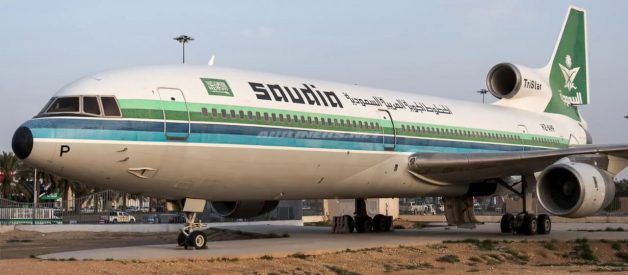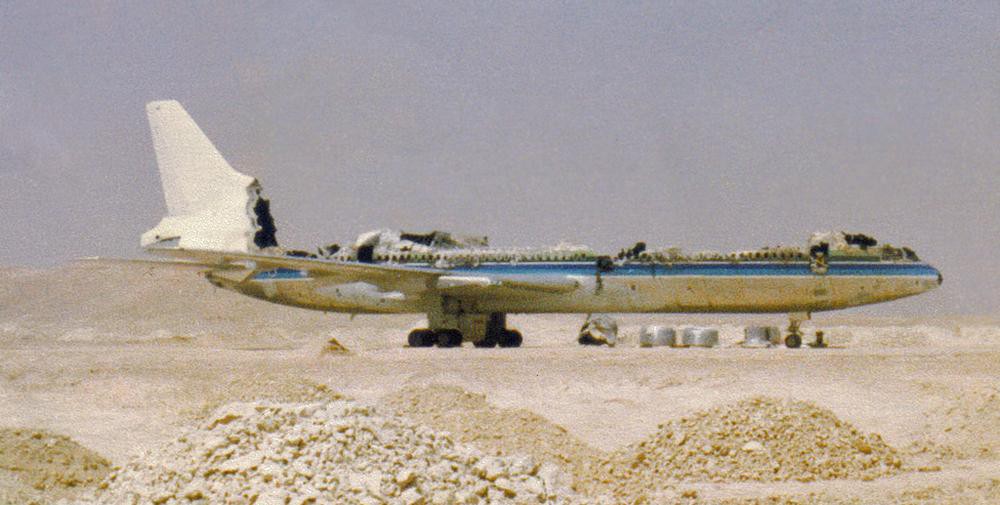 The burned-out hulk of flight 163 after the accident. Image source: the Bureau of Aircraft Accidents Archives
The burned-out hulk of flight 163 after the accident. Image source: the Bureau of Aircraft Accidents Archives
On the 19th of August 1980, one of the deadliest disasters in aviation history unfolded on the runway at Riyadh International Airport in Saudi Arabia?s capital. 301 people lost their lives as a Lockheed L-1011 Tristar made an emergency landing due to an in-flight fire, then mysteriously went silent before anyone left the aircraft. The horrifying disaster boggles the mind: somehow, no one on board the jumbo jet survived a flight that never even crashed. Although much about the accident remains unknown, this article attempts to parse the information that is available from the official accident report and other sources to tell the story of the ill-fated flight as accurately as possible.
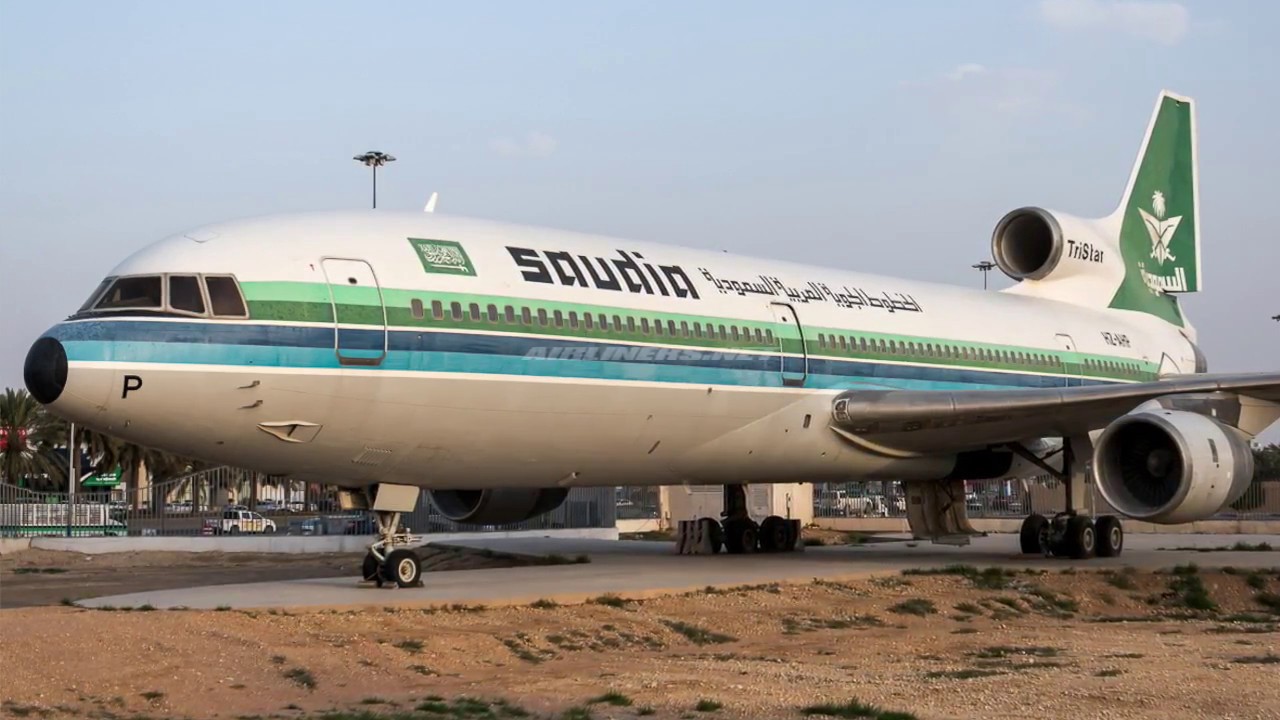 A Saudia Lockheed L-1011 Tristar. Image source: Airline Spotter
A Saudia Lockheed L-1011 Tristar. Image source: Airline Spotter
Saudia flight 163 was a regularly scheduled flight from Karachi, Pakistan to Jeddah, Saudi Arabia with a stopover in Riyadh, operated by Saudi Arabia?s national airline using a wide body Lockheed L-1011 Tristar. The first leg from Karachi to Riyadh was normal, and after the intermediate stop at Riyadh International Airport, 287 passengers and 14 crew boarded the aircraft for the journey westward to Jeddah. Some of the crew and about half the passengers were Saudi nationals, while 85 passengers were from Pakistan and 32 from Iran. Most of these passengers were heading to Jeddah to participate in the hajj, because Jeddah is the main international gateway for travelers to Mecca.
In command of the flight were Captain Mohammed Ali Khowyter, age 38; First Officer Sami Abdullah Hasanain, age 26; and Flight Engineer Bradley Curtis, age 42. Captain Khowyter had been a pilot for Saudia since 1965, but had only recently switched to flying L-1011s and had just 388 hours on the aircraft type. He also experienced difficulties during training. Instructors had at various points commented that Khowyter ?Had difficulty when requested to vary from a set pattern,? was mentally ?behind his aircraft,? was ?slow to learn,? ?needed more training than normally required,? ?failed recurrent training,? and ?had problems in upgrading [to another aircraft].?
First Officer Hasanain had been flying for less than two years and had only 125 hours on the L-1011. In 1975, he had been dropped from Saudia?s pilot training program due to poor progress. In 1977 he was one of several previously dropped trainees who were reinstated by committee action, and he was finally hired in 1978.
Flight Engineer Bradley Curtis, a US citizen, had worked for Saudia since 1974 but had only been certified on the L-1011 for three months and had 157 hours on the type. He suffered from dyslexia, a condition which made it difficult for him to read. In 1975 he failed out of captain training on the Boeing 737. In 1977 he managed to become a first officer on the 737 but was fired after failing a check ride in 1978. Apparently desperate, he offered to pay for his own training to become a flight engineer if Saudia would rehire him afterward. This offer was accepted and he was back with Saudia as a flight engineer in 1979.
The total L-1011 line experience of the three members of the flight crew was only 670 hours and all three were below-average pilots, according to their training records.
At 9:08 pm, Saudia flight 163 took off from Riyadh and began climbing toward its cruising altitude. Captain Khowyter started whistling and singing, a habit which would resurface repeatedly throughout the flight.
It wasn?t long before things started to go wrong. 7 minutes after takeoff, one of the two fire alarms (A and B) in the rear C-3 cargo compartment went off, alerting Flight Engineer Curtis to the presence of a fire. From this point on, all quotes are taken directly from the CVR transcript, which is included almost in its entirety.
Alerting the captain to the problem, Curtis said, ?B aft cargo??
?What?? Khowyter asked.
?B aft cargo!? Curtis repeated.
First Officer Hasanain broke his silence to ask, ?What?s going on?? It is apparent at this point that Curtis? lack of specificity was confusing the other pilots. What was ?B aft cargo? supposed to mean?
?Smoke detection, B aft cargo,? Curtis said, finally explaining what was wrong with the aft cargo compartment.
?Stop ventilation,? Khowyter ordered. As it turned out, this might have had deadly consequences later.
?Smoke detection! Smoke detection, B aft cargo!? Curtis said again, apparently still assessing the situation for himself.
?In B aft cargo?? Khowyter asked.
?Yes,? said Curtis.
Khowyter further asked, ?Did you turn it to the other one?? What he meant here is not at all clear.
?Just in B,? said Curtis.
?What??
?Not in A. Just in B.? Curtis meant that smoke detector A in the C-3 compartment had not gone off, only smoke detector B, but it seems doubtful that this is what Khowyter was asking about.
?Just B,? said Khowyter.
?Yeah, said Curtis, ?A is okay.?
Khowyter relaxed. ?Okay, so we can go on,? he said. Incredibly, he seemed to believe that the activation of only one smoke alarm was insufficient to divert the flight.
?Yes,? said Curtis.
?The ventilation is not working in that one,? said Khowyter. Again, it is unclear what he was referring to.
?Yeah,? said Curtis, just in time for the other C-3 cargo compartment smoke alarm to start blaring. ?There is A,? he said.
?What??
?Now it is A, both of them.?
?So, we got to be returning back, right?? Khowyter asked, as though it wasn?t his decision.
?Both A and B aft cargo smoke detection,? Curtis repeated.
?So we have smoke there,? said Khowyter.
Curtis agreed. ?I would say so, yeah,? he said.
Incredibly, the pilots spent all this time deciding whether the activation of a smoke alarm indicated the presence of smoke! A little over one minute had now passed since the smoke alarm first activated.
So far, the pilots seemed slightly slow on the uptake, but not dangerously so. It was rapidly becoming clear that this was a serious situation which warranted their undivided attention.
?What?s the procedure for it in the checklist?? Khowyter asked.
?Yeah, I am looking for it now,? said Curtis, leafing through the handbook looking for the appropriate checklist for this situation. It couldn?t have helped that Curtis?s dyslexia made it a struggle for him to read. Khowyter went back to singing.
For some time Curtis tested to make sure the alarm wasn?t false, while narrating everything he was doing.
After the test showed the alarms were working properly, Khowyter said, ?We have cleared the situation.? It?s not clear why he said this or what he meant; perhaps he was misinterpreting the purpose of Curtis? test.
Following up on Curtis? earlier attempt to find the appropriate checklist for smoke in the cargo hold, Khowyter said, ?There isn?t anything about it in the abnormal procedures, huh??
?Nothing about it,? said Curtis. ?Should I just go back there and see if I can find anything or smell anything?? Somehow, he failed to find the checklist even though he did look in the right section of the handbook, under ?abnormal procedures.?
?What??
?Shall I go back there and see if I can smell anything?? Curtis repeated.
?Okay, sure,? said Khowyter.
Curtis opened the cockpit door and added, ?If I can see, smell something I think we better go back.? After another short exchange, Curtis left the cockpit to check the cabin for signs of smoke. In the back of the passenger cabin, smoke was already seeping out of the cargo hold, catching the attention of passengers seated in the last few rows on the left side. Meanwhile in the cockpit, the captain and first officer continued discussing the situation.
Breaking his silence, Hasanain said, ?Strange, no procedure for it??
?No procedure for it?? Khowyter said, pausing momentarily. ?Tell them we?re returning back.?
?To Riyadh,? Hasanain said.
?We are sixty miles out,? said Khowyter. ?Uh? we better go, go back to Riyadh.?
Only now, 4 minutes after the smoke detection, did the pilots decide to return to the airport. This was not considered excessive at the time, although it would be today.
?By the way,? Khowyter said to Hasanain, ?he?s a jackass. In the abnormal, it is in the checklist.? Khowyter, evidently doubting his flight engineer?s capability, had checked the handbook himself and found the checklist for smoke in the cargo hold.
Some fifteen seconds later, Curtis returned to the cockpit. ?We?ve got a fire back there,? he said, slamming the door behind him.
?We do?? Khowyter asked.
?Yes we do,? said Curtis.
?It?s? okay, call please,? Khowyter said to Hasanain. ?Tell him we?re coming back.?
Hasanain keyed the radio and said, ?One six three, we?re coming back to Riyadh.?
?I would declare an emergency,? Curtis suggested.
?Yeah,? said Khowyter.
?Cleared to reverse course to Riyadh,? said the controller, ?and, request reason??
?Declare emergency?? Hasanain asked.
At that moment, a flight attendant burst into the cockpit. ?Fire, fire in the cabin!? she said.
Hasanain keyed his mic again and told the controller, ?Saudia one six three, we?ve got fire in the cabin and please alert the fire trucks.? He did not declare an emergency.
?Okay, cleared back,? said the controller. ?And if you?d like to descend, you can descend to any altitude you like.?
?Okay,? Hasanain acknowledged. At Riyadh International Airport, fire trucks scrambled to intercept the incoming L-1011.
By this point, judging by the flight attendant?s comments, the raging fire in the cargo hold had apparently burned through the cabin floor near the last rows of seats on the left side. Passengers in the rear smoking section would have started to panic and try to move forward, although all indications are that the flight attendants managed to maintain order at this point. While Hasanain handled more procedural radio communications, one of the flight attendants went on the public address system and announced, ?Ladies and gentlemen, you are request to return to your seats!?
Meanwhile on the radio, the controller asked, ?Is fire on engine, confirm??
?Negative, in the cabin,? said Hasanain.
In the background, Khowyter told Curtis to ?take a look in the cabin? again.
?Check how many passengers you have on board?? the controller asked.
?How many passengers?? Hasanain asked, turning to Khowyter.
?Tell him we do have full load up actually, we don?t know,? said Khowyter. The plane wasn?t quite full, but he was close; with 301 people on board, the plane was certainly packed, if not quite full.
?We don?t know exactly, think we have full load,? Hasanain told the controller.
Meanwhile, the flight attendants repeated their message over the PA. ?Will all passengers remain in their seats and fasten seat belts,? she said. ?I repeat, all passengers to remain in your seats, all passengers remain in your seats.?
Moments later, Curtis returned to the cockpit and started to say, ?Okay, it?s a ? ?
?Yeah?? Khowyter asked.
?It?s just a fire in the ah, smoke,? Curtis said, stumbling over his words.
?What??
Curtis clarified. ?It?s just smoke in the aft,? he said. This was inconsistent with the flight attendant?s observation of fire, so perhaps the actual flames were obscured by smoke when he went back to look. Regardless of the reason, this probably gave Captain Khowyter the impression that the situation was less dire than it actually was.
?Okay,? said Khowyter, ?We?re going to the Riyadh, back.?
?Okay, no problem,? said Curtis.
?Okay.?
?Okay, no problem, so we are going to be returning. Everybody?s panicking in the back though,? he added, apparently having observed passengers fleeing the fire. However, his repetition of ?no problem? ? probably to try to calm himself ? may have signaled to Khowyter that the situation was under control, when it decidedly was not.
While Hasanain called out navigational information, Curtis kept muttering to himself, ?no problem, no problem, no problem at all.?
A flight attendant entered the cockpit and asked, ?Do we have time to take the carts back?? She was referring to the serving carts, which had been taken out of their storage space in the downstairs galley, accessed via the galley elevator. The crew hadn?t said how long they had until landing, and the flight attendants wanted to make sure the aisles were clear for the evacuation ? but they also didn?t want to be stuck in the downstairs galley on touchdown.
?What?? Curtis asked.
?To take the carts down to be out of the way??
?All right, take them down,? said Curtis.
Meanwhile, Khowyter and Hasanain prepared for landing. ?Okay, get the landing weight, boy,? Khowyter said to Curtis, who was notably his senior. ?Get the landing weight.?
?Okay, it will be one six zero,? said Curtis.
?Okay.?
?Did we declare an emergency?? Curtis asked.
?Negative,? said Khowyter. Although they absolutely should have declared an emergency, at least everything they would need for the emergency landing was in order.
For 15 seconds or so, Khowyter and Curtis discussed whether the fire trucks had been alerted, until Hasanain finally butted in to explain that he already asked for them.
As the approach continued, Curtis said, ?We definitely want ? we definitely, we definitely want preference to land.?
?Huh??
?We definitely want preference to land, that?s for sure.?
?Yeah,? said Khowyter. He and Hasanain were now going through the approach checklist. ?Pressurization is set??
In the background, a flight attendant made another PA announcement.
?No smoking sign on?? said Hasanain.
?Okay, no smoking sign,? said Khowyter. They were evidently using the normal approach checklist, as though this wasn?t an emergency landing.
They rattled off more minor settings.
?Anti ice??
?Off.?
?HSI heading set??
?Set.?
?Seatbelt sign??
?On.?
?Uh, logo light??
?Checked.? Even in the middle of a dangerous emergency, they bothered to turn on the logo light on the tail! They rattled off more items, most of them somewhat more important: altimeters, airspeed and groundspeed bugs?
Another smoke alarm went off. ?What can I say?? said Curtis.
?Okay,? said Khowyter.
?I think it?s all right now,? said Curtis, again giving the impression that the situation was fine. Another 15 seconds dragged on as the pilots went through the checklist. Another smoke alarm went off. Captain Khowyter started singing.
There was a momentary flurry of activity during which Hasanain discussed the radio while a flight attendant made another PA announcement in the background. Suddenly, Captain Khowyter observed a new problem while trying to reduce thrust for the descent into the airport.
?Okay, the throttle in engine number two, it?s not returning back ? stuck,? he said, trying to get the throttle to move. In fact, the fire had partially melted the plastic insulation around the cable connecting the throttle to the tail-mounted number two engine, causing the cable to jam.
?Stuck?? Curtis asked.
?Stuck,? Khowyter affirmed.
?I would leave it the way it is, sir,? said Curtis. The engine hadn?t failed ? it was still running, but they couldn?t change the power setting.
?Huh??
?Just leave it the way it is.?
?I?m going to shut it down,? said Khowyter. He didn?t want the extra unwanted thrust making the descent more difficult.
A flight attendant entered the cockpit once again. ?We tried to, we tried to put it off, at L4 there is fire!? she said, referring to the rearmost exit door on the left side. Back in the cabin, flight attendants had grabbed six fire extinguishers from the front of the airplane and were discharging them one by one into the fire in a futile attempt to quench the inferno.
?There?s fire?? Curtis asked, apparently oblivious to the pandemonium in the rear of the plane.
?Yeah,? said the flight attendant.
?Well, go put it out!? Curtis suggested, although this was a totally useless suggestion. Perhaps Curtis believed that it was simply something burning in a passenger?s carry-on that could be easily contained.
The frustrated flight attendant could only ask, ?How??
?In the, ah, the fire extinguisher,? said Curtis.
?I know, I said we will do it!? said the flight attendant.
Turning to the pilots, Curtis said, ?There?s a fire back there,? as though this wasn?t already obvious.
?Okay,? said Khowyter, turning to Hasanain. ?Tell them we have actual fire in the cabin.?
?Riyadh Saudi Arabia one six three, we have an actual fire in the cabin now.?
?Shall I let Jeddah know on HF?? Curtis asked.
?No,? said Khowyter. There was no reason to inform the destination airport that they wouldn?t be arriving.
?Saudia one six three, roger, the fire [sic] are in the standby positions and they are ready,? said the controller.
?No?? Curtis asked, continuing the earlier conversation.
?Not with our situation,? said Khowyter.
?Would passengers please remain seated!? a flight attendant said over the PA. ?L4 and R4, get the fire extinguishers from the galley!? She repeated the instruction again, and the specified flight attendants rushed to get additional fire extinguishers.
?Jeez, let?s go on as fast as we can till we get to approach,? Curtis said.
?That?s it, this is the maximum,? said Khowyter, apparently already pressing the descent.
?Yeah.?
?Now number two is stuck there, so something is wrong with it,? Khowyter said. ?I?m gonna be, shut it down.?
But just when he was about to act, Curtis said, ?Well, not yet, not yet, not yet!?
Once again, a flight attendant burst into the cockpit. ?There is no way I can go to the back? after R2 and L2,? she said, referring to the overwing exits, ?because the people are fighting in the aisles!? Clearly the situation in the cabin was growing dire, with people from the back of the plane pushing forward to get away from the heat and smoke.
?Okay, find a way if you can,? said Curtis.
The flight attendant went on the PA again. ?L4, R4, L3, R3,? she commanded, ?open the cabinet and use all your fire extinguishers and the CO2!?
?I?ll keep your speed up as long as possible,? Curtis said to Khowyter, possibly explaining the reason for his desire to keep the stuck number two engine running.
?Okay,? said Khowyter, ?As soon as possible we?re gonna be down.?
?All passengers remain in your seats!? the flight attendant said over the PA again, in Arabic.
The pilots set their desired landing speeds while the flight attendant continued to make announcements in an attempt to get people to make way for the additional fire extinguishers. ?Please, everybody sit down!? she shouted in English. ?Move out of the way, everybody sit down, move out of the aisle, there is no danger from the airplane, everybody stay in their seats!? Switching to Urdu, she added, ?Sit on your seat, sit on your seat, ladies and gentlemen take your seat ? nothing will happen to aircraft! Ladies and gentlemen, fasten your seatbelt, don?t stand like this, sit on your seats ? sit down, sit down!? It was a futile gesture, lost in the chaotic rush of passengers desperate to get away from the flames.
Meanwhile in the cockpit, Curtis scanned the instruments. ?Piece of cake, piece of cake,? he said, probably trying to calm himself. ?As soon as we land, sir, I suggest that we turn off all fuel valves.?
?Okay.?
?As soon as we land.?
?Okay.?
?As soon as we touch down.?
?Okay,? said Khowyter. To Hasanain, he asked, ?Where is the runway? Can you see the runway??
?No, not yet, not yet,? said Hasanain. ?28 miles!?
?Did you tell the fire trucks to go to the back of the plane as soon as possible??
?Yeah,? said Hasanain, although he had not in fact specified that the fire was in the back of the plane.
In the background, the flight attendant continued her desperate efforts to clear the aisles. ?Will all passengers remain seated, will all passengers remain seated!? Switching to Urdu again, she shouted, ?Ladies and gentlemen, sit down!?
Captain Khowyter spent the next few moments urging First Officer Hasanain to tell the controllers where exactly the fire was located, until he finally did so. They immediately switched back to looking for the runway.
?Where is the airport?? Khowyter asked. ?I don?t see it.?
A flight attendant leaned into the cockpit again, ?Captain,? she said, ?there is too much smoke in the back.?
?There is the airport road,? said Hasanain. ?The yellow lamps are the airport road.?
?That??
?Yeah.?
Finally acknowledging the flight attendant, Khowyter asked, ?Are there too much smoke there??
For some reason, Curtis tested the alarm system again. ?Okay, there?s both A and B loops working again,? he said, ?And no indication of smoke.? Where he got this obviously erroneous reading is not at all clear.
?Huh,? said Khowyter.
?No indication of smoke, however, the cabin is filled with smoke in the back,? said Curtis.
?Okay, now number two engine is stuck,? said Khowyter, as though noticing for the first time.
?I suggest we shut it down on short final,? said Curtis.
?Yeah, short final,? Khowyter repeated.
Curtis kept fiddling with the smoke alarms. What he was trying to do is left up to the imagination.
A passenger went on the PA and implored his fellow passengers to sit down, in Arabic.
?What is he saying?? Curtis asked.
?Trying to keep them calm, keep them down,? said Hasanain.
Now on final approach, the pilots set the flaps for landing, while someone continued to speak over the PA, ordering the passengers to be seated. There followed a confusing exchange between Hasanain and Khowyter in which Hasanain repeatedly mentioned the ?first people? that they had been ?talking about,? although Khowyter never seemed to figure out what his first officer meant.
Changing the subject, Khowyter said, ?Where is the airport? I don?t see it.?
?You see those lights over there? That?s the stadium,? said Hasanain. ?I got the field in sight.?
?I am just trying to intercept this?? Khowyter said.
A flight attendant entered the cockpit yet again. ?Shall we evacuate?? she asked.
?What?? Khowyter asked.
?Did you say we should evacuate ? ?
?What??
? ? the passengers??
?Say again?? said Curtis.
?Can we evacuate all the passengers??
?When we?re on the ground, yes,? said Curtis, making perhaps his most boneheaded comment of the entire flight. Captain Khowyter called out flap settings in the background.
?Okay, after we are on the ground, yes,? said the exasperated flight attendant. At least she got her order to evacuate!
Captain Khowyter and First Officer Hasanain proceeded through the normal landing checklist as the plane approached the airport, checking many of the same items as they reviewed in the approach checklist.
?Okay, right after landing sir, do you want me to turn off all fuel valves?? Curtis asked.
In a response to rival Curtis? literalist ?when we?re on the ground? comment, Khowyter replied, ?No, after we have stopped the aircraft.?
The flight attendant, still in the cockpit, now asked Khowyter the same question she asked to Curtis moments earlier. ?Do you want us to evacuate passengers, captain??
?What??
?Do you want us to evacuate the passengers as soon as we stop??
?Take your position,? he told her, without answering her question. One of the most important steps in an emergency landing with a fire on board is to make sure the flight attendants are ready for an immediate evacuation, but Khowyter seemed entirely nonchalant. Was he really so oblivious to the danger his aircraft was in? We may never know.
Another warning sounded on the flight engineer?s panel. ?The area duct overheat,? Curtis said.
?Okay,? said Khowyter, following up with a new flaps setting.
The flight attendant went on the PA and passed on Khowyter?s order for the flight attendants to take up their positions.
?Got runway in sight?? Hasanain asked.
?Oh yeah, I see it,? said Khowyter.
Hasanain keyed his mic and said, ?Riyadh, one six three, we got the runway in sight, are we cleared to land??
?Affirmative, you are number one, cleared for approach and you can continue tower one eighteen one,? said the approach controller, transferring them to the tower controller. Hasanain now asked the tower controller for landing clearance, which was granted.
?All of you sit down!? a flight attendant said over the PA back in the passenger cabin. ?Fasten seatbelts, all of you sit down!? she repeated, in Urdu this time.
?Okay, I?m shutting ? okay, I?m shutting down engine number two,? said Khowyter. ?it?s stuck, present EPR.?
While Khowyter shut down the engine, Hasanain again confirmed that the fire trucks were in position.
?Okay, it is coming down,? said Khowyter, referring to the power on the number two engine.
The pilots made more final pre-landing configuration adjustments. On the PA, the flight attendant could be heard saying, ?Give me your attention please, be seated ladies and gentlemen, we are about to land ? there?s no reason to panic!? Of course, both she and the passengers probably knew that there was every reason to panic.
While the crew continued to make final adjustments, the flight attendants persisted in trying to calm the passengers. ?We?re about to land, ladies and gentlemen, place your hands behind your head for impact!? she said. To the other flight attendants, she ordered, ?Girls, demonstrate impact position, girls, demonstrate impact position.?
On the flight deck, Khowyter called out ?gear down? and the landing gear dropped into place.
?Okay, you can go one ninety,? said Curtis, referring to the landing speed he had just calculated.
?Good,? said Khowyter. ?There is no, any procedure for the two engine, it?s the same as three,? he added, confirming that there were no special steps needed to land with only two engines.
?Okay,? said Hasanain.
?I just want to confirm it, I know it god damn it,? said Khowyter. Turning to Hasanain, he added, ?Tell him the engine number two is ? should be shut down ? it?s stuck.?
?Okay.?
?Tell the tower!?
?Yeah.?
?Yeah, we just have engine number one,? said Khowyter. It?s not clear what he meant, since both engines one and three were functional.
While Hasanain informed the tower that they had shut down an engine, the flight attendant went back on the PA yet again to give final brace instructions. ?The girls have demonstrated impact position, please go down half a minute before touchdown, it?s half a minute before touchdown, hands behind your head.? There was a moment?s pause, then she continued. ?Everybody, please sit down, everything?s under control, we are landing back at Riyadh! Please sit down and fasten your seatbelts, sit down and fasten your seatbelts please.?
Khowyter announced that the final checklist was complete, and Curtis ran through the last items, confirming everything was in order. For some reason he announced the activation of the smoke alarm again.
On the PA, the flight attendant repeated in Urdu, ?Ladies and gentlemen, no need to panic, place your hands behind your head for impact position!?
?Aft cargo door is open sir,? said Curtis, reacting to a false warning caused by the fire. The door was in fact closed.
?Check?? said Khowyter.
?No problem,? said Curtis. On the PA, the flight attendant kept repeating the brace instructions over and over. Eventually Curtis interjected again. ?The girls wanted to know if you want to evacuate the airplane,? he said to Khowyter. He had to repeat this twice to be understood.
On the ground, witnesses saw the plane coming in to land with smoke streaming out of its tail.
The pilots called out more flaps settings. Curtis identified another smoke alarm. Someone announced, ?Five hundred [feet].? Curtis noted low pressure on the number two hydraulic system, which had been powered by engine number two.
Khowyter started signing again.
?Looking good,? said Curtis.
Then, in perhaps the most fateful comment of the flight, Khowyter said, ?Tell them ? tell them not to evacuate.? 25 seconds later, the cockpit voice recorder cut out almost at the moment of touchdown. What exactly happened in the cockpit after this will never be known.
21 minutes after the first fire alarm, Saudia flight 163 touched down smoothly on the runway in Riyadh. The rollout was normal, except for the fact Captain Khowyter braked only gently, even though full braking power was available. The L-1011 rolled down the runway for two minutes and forty seconds, while fire engines chased along behind. Finally, almost at the end of the runway, the plane pulled off to the left into a taxiway and came to a stop. Fire trucks approached the aircraft, but found that the engines were still running, making it dangerous to get close. Fire crews observed flames in the rearmost four windows on the left side, and when the fire suddenly burst through the top of the fuselage, they started spraying the plane with as much foam as they could muster. Meanwhile, the controller relayed to the crew the firefighters? concern about the engines. The pilots acknowledged, and shortly afterward the engines were finally shut down.
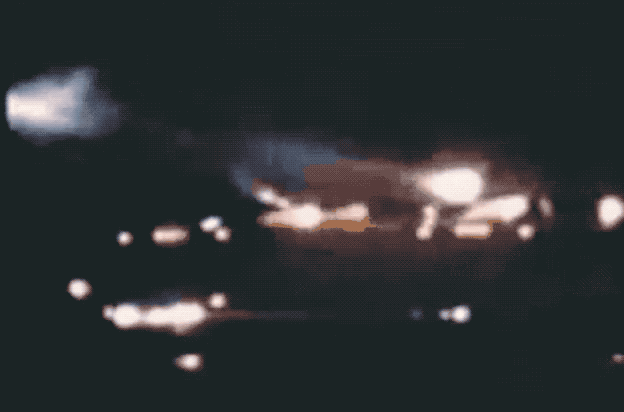 Firefighters tackle the blaze. Video source: Wold in Action
Firefighters tackle the blaze. Video source: Wold in Action
Inside the cabin, passengers flooded toward the forward exits while smoke rolled down the aisles. But the flight attendants never attempted to open the doors ? either they had been told not to, or they couldn?t reach them. In the tower, controllers heard the last transmission from the aircraft: ?Affirmative, we are trying to evacuate now.? After that, all calls were met with silence.
At that moment, toxic smoke containing carbon monoxide, nitrous oxide, hydrogen cyanide, ammonia, and other deadly chemicals swept through the plane. Its spread was exacerbated by the pilots? inexplicable decision to close all the vents, which prevented the fumes from escaping the aircraft. The smoke quickly overcame the passengers and crew as they queued for the still-unopened exits, killing all 301 people on board.
The firefighters at Riyadh international airport had never fought an aircraft fire before, neither in the line of duty nor in a simulation. They also knew next to nothing about the Lockheed L-1011 or how to operate its many exterior doors. Firefighters finally managed to open a door more than 23 minutes after the engines were shut down. Observing dense smoke inside the plane, firefighters called out to anyone who might be alive, but there was no response. Moments later, a flashover caused accumulated gases to combust, and fire rolled down the length of the plane, forcing the firefighters to retreat. The plane burned for some time, destroying everything above the window line. The next morning, the hollow husk of the L-1011 stood there on the taxiway, a grisly monument to the hundreds who perished in what was then the third deadliest plane crash of all time. (Today, it ranks sixth.)
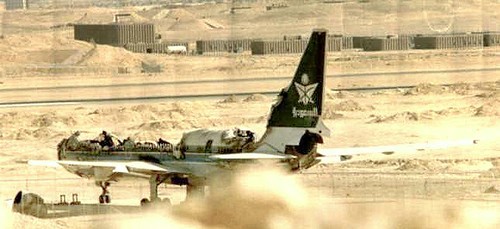 The L-1011 after the fire. Image source: the FAA
The L-1011 after the fire. Image source: the FAA
The investigation was unable to answer some of the most vexing questions about the accident. What exactly started the fire was never determined, because the evidence had burned away. The most likely explanation was that something in a passenger?s baggage caught fire: perhaps a box of matches, or a bottle of kerosene for cooking on the trek to Mecca. Although these items weren?t allowed on the plane, screening consisted only of random checks, and anyone who wanted to bring them on could probably have done so. Previous incidents had shown that it was surprisingly easy to ignite any of these items inside passenger baggage. The resulting fire overpowered the protective panels on the ceiling of the cargo compartment and allowed fire to burn into the passenger cabin. This was contrary to the compartment?s ?Class D? designation, which was supposed to mean that a fire inside would self-extinguish. In practice, however, the materials from which the compartment was made proved insufficient to actually contain a fire. As a result, the Saudi investigators recommended that the FAA change the designation of the L-1011?s aft cargo compartment to a class with more fire protections appropriate to its level of vulnerability.
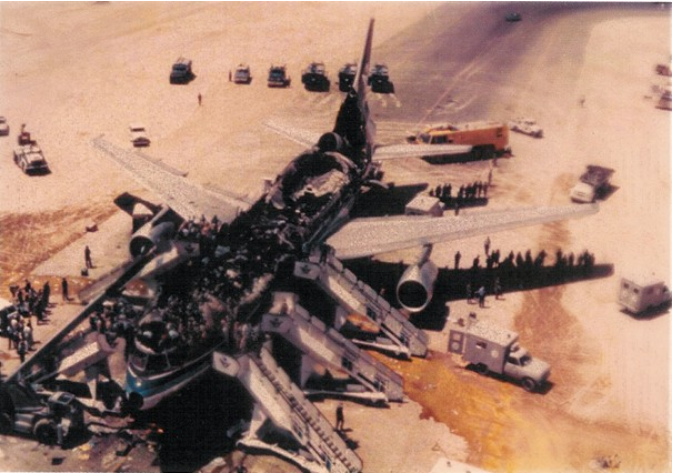 Stairs were brought to allow access to the jet. Image source: the FAA
Stairs were brought to allow access to the jet. Image source: the FAA
Although the fire on board flight 163 was a very serious emergency, it was clear that the high fatality count was the result of errors made by the crew. Investigators calculated that if the pilots had brought the plane to a stop as quickly as possible and ordered an immediate evacuation, most likely everyone would have survived. The investigation was unable to conclusively determine the reason for the delay, but there are a couple of possibilities. First, evidence from the cockpit voice recording ? laid out almost in full in this post ? shows that Captain Khowyter might never have realized the seriousness of the blaze. He could be heard singing and whistling throughout the flight. He never ordered First Officer Hasanain to declare an emergency. He spent time running through parts of the approach and landing checklists that seemed entirely incongruent to the urgency of the situation. There were plenty of indications from the flight attendants that the situation was dire, but he might not have heard these, or perhaps he was lulled into a false sense of security by Flight Engineer Curtis? repeated assertions that there was ?no problem? and that things were under control. There very much was a problem, but investigators believed Curtis might simply have been trying to calm himself rather than giving his actual interpretation of the situation.
The pilots also displayed poor crew resource management during the emergency. Curtis repeatedly made helpful suggestions for the evacuation that Captain Khowyter ignored. First Officer Hasanain was also a complete non-presence who tended to speak only when ordered to do so by Captain Khowyter. Of all the cockpit crew, Curtis seemed to be the most cognizant of the danger they were in, but Khowyter?s comment that the flight engineer was a ?jackass? or ?donkey? suggests that he did not look beyond Curtis? human faults to see that his advice was actually useful.
Another theory, more sinister but somewhat less believable, was made known by a witness to the accident nearly 30 years after it occurred. Michael Busby, an American defense contractor, owned a villa overlooking the airport and watched the accident unfold. He asserted in a 2010 article that the reason flight 163 had not come to a stop and evacuated immediately was the presence of the Saudi king?s Boeing 747, which he observed was about to take off right as flight 163 was arriving. According to Busby, protocol mandated that all traffic pause and make way when the king?s 747 was taxiing, and he believed that the crew of flight 163 feared punishment if they delayed his departure by evacuating 300 passengers onto the active runway.
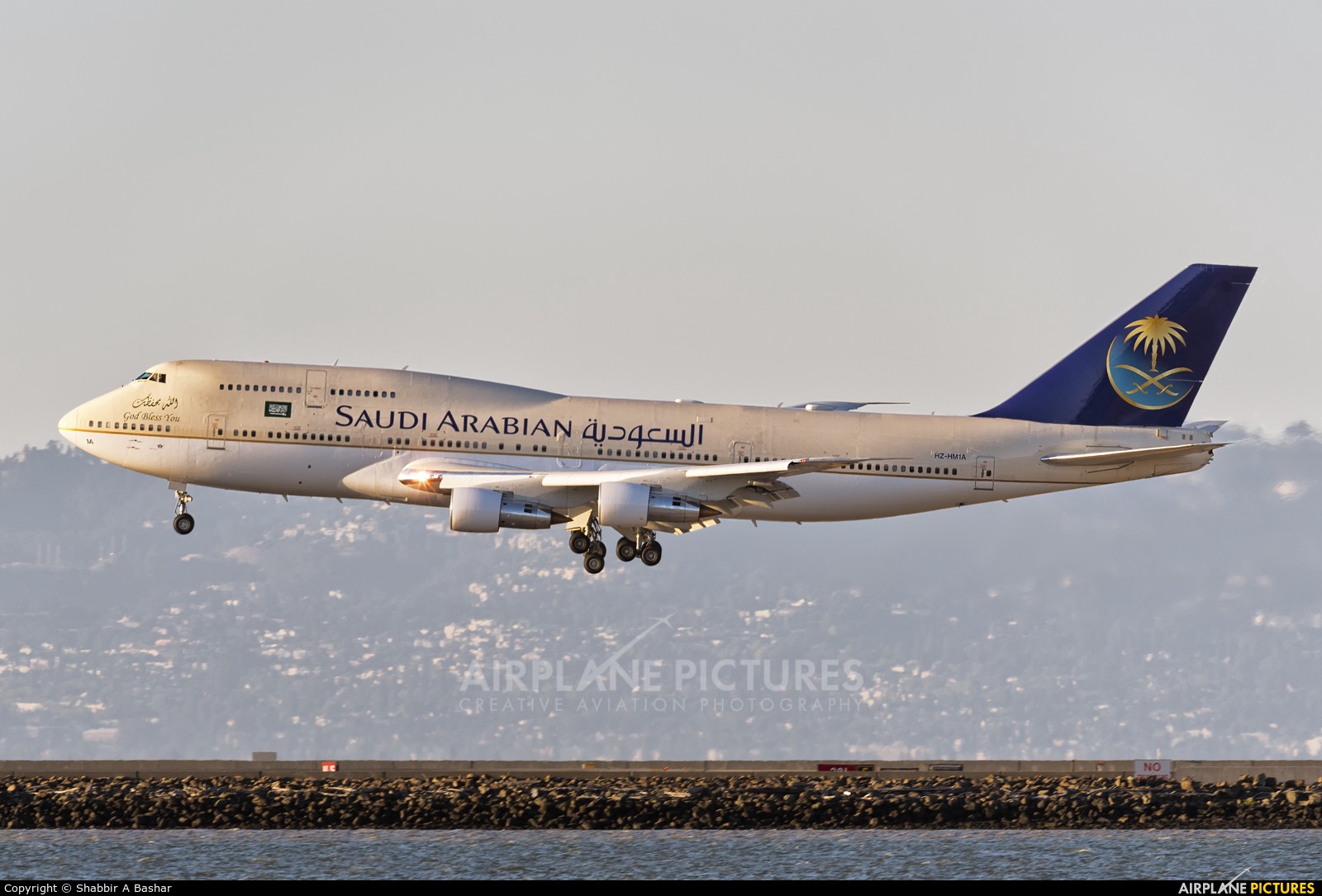 The Saudi king?s Boeing 747. Image source: Shabbir Bashar
The Saudi king?s Boeing 747. Image source: Shabbir Bashar
The presence of the king?s 747 is obliquely corroborated in a single line of an appendix to the accident report, in a summary of a witness statement by an airport employee. The employee, Nasser Al-Mansour, stated that at the time of the accident he was with the ramp supervisor making an inquiry about ?the departure of 747 aircraft HM-1.? The report certainly makes no mention of the fact that 747 HM-1 is the Saudi king?s aircraft!
There is reason to doubt Busby?s account of events, however. He claimed that fire trucks were also prevented from responding due to the presence of the king, but every other witness clearly saw fire trucks chasing the L-1011 down the runway and gathering around it as soon as it came to a stop. The pilots? final transmission, in which they said that they were ?trying to evacuate now,? also doesn?t support the idea that the crew waited for the king?s departure, since the 747 had not yet taken off at that time. Investigators believed it was likely that this belated attempt to evacuate was stymied because panicked passengers pressing against the exit doors prevented flight attendants from opening them.
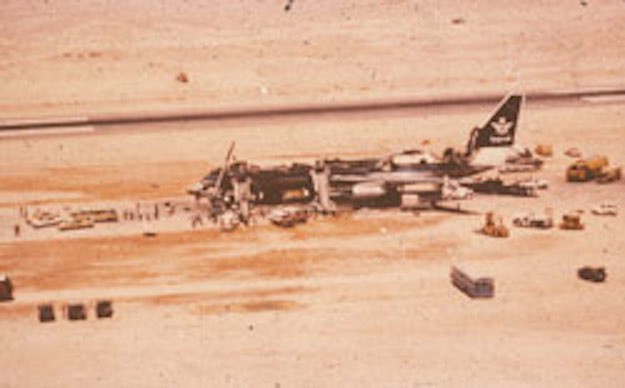 Cleanup of the debris and victims begins. Image source: the FAA
Cleanup of the debris and victims begins. Image source: the FAA
In trying to explain the pilots? grave errors, the investigation naturally turned to their training histories. Khowyter, Hasanain, and Curtis all had few hours on the Lockheed L-1011 and none were considered to be gifted pilots. Khowyter?s difficulty in deviating from set patterns, noted in training, could explain why he appeared to treat the emergency landing as a totally normal approach to Riyadh. Curtis? dyslexia probably made it hard for him to read his instruments and almost certainly prevented him from finding the right emergency checklist. Hasanain, in addition to being young and inexperienced, probably shouldn?t have been in a cockpit at all. The report does not explain why he was ?reinstated by committee action? after failing out of the training program two years earlier, but it suggests that he could have been rehired due to nepotism, bribery, or some other insider connection. Alternatively, Saudia might have been struggling to hire pilots and therefore reconsidered trainees who had earlier been rejected. Either theory is simply speculation.
In the end, no single explanation adequately accounts for all the unanswered questions that still surround the tragedy of flight 163. But the investigation still made numerous recommendations, including the aforementioned change to the cargo compartment classification. The commission recommended that crews be trained to take immediate action if smoke is seen, instead of waiting to determine the severity of the fire; that Saudia train its first officers to be more assertive, make sure inexperienced pilots are not placed together, stop reinstating trainees who failed out of their training program, and hire personnel to more thoroughly check baggage for disallowed items; and that Riyadh International Airport overhaul its training of firefighters to ensure that they are adequately prepared to save lives in an emergency situation. As a result of the recommendations, Saudia did make changes to pilot training and closed ventilation outlets to and from the C-3 cargo compartment on its L-1011s.
Notably, 16 years later, Saudia was involved in an even deadlier accident in the skies over India when a fully loaded Saudia Boeing 747 collided in midair with a Kazakhstan Airlines Ilyushin Il-76, killing all 349 people on both aircraft. Although Saudia?s crew was not at fault in the accident, it did earn the dubious distinction of being the only airline involved in more than one of the six total crashes that have resulted in more than 300 fatalities.
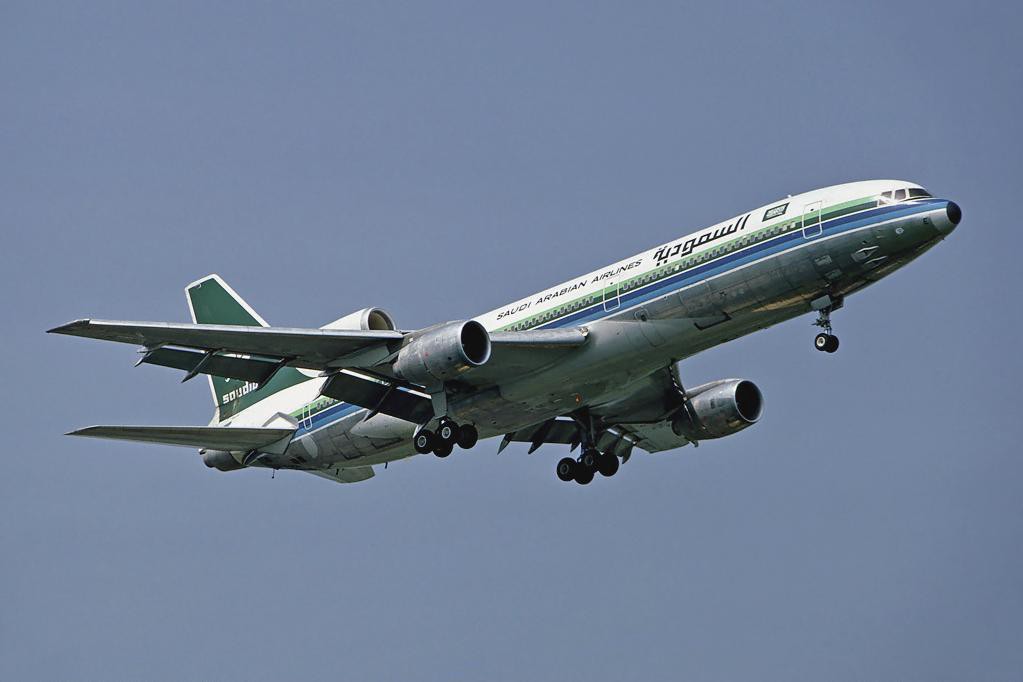 A Saudia L-1011 returns to the sky. Image source: Wikipedia
A Saudia L-1011 returns to the sky. Image source: Wikipedia
One final takeaway from the tragedy is that despite the apparent incompetence of the flight crew, the flight attendants acted heroically until the very end. The 11 cabin crew, most of whom were Filipino, bravely fought the fire until they ran out of extinguishers. At least five empty Co2 extinguishers and at least one water extinguisher were found in the wreckage of the cabin, strewn near the area where the fire originated. Another two fire extinguishers might have been used as well, but were too badly damaged to determine if they had been discharged. The scenes inside the cabin can only be imagined as the flight attendants pushed through the panicking passengers, running toward danger instead of away from it, and emptied one extinguisher after another into the face of the inferno that ultimately took their lives. Their constant announcements providing safety information, their efforts to calm the terrified passengers (while doubtlessly terrified themselves) and clear the aisles for the evacuation, and their repeated attempts to extract an evacuation order from Captain Khowyter further showed that their emergency response went above and beyond the call of duty. The names of the flight attendants on board Saudia flight 163, who so desperately fought to prevent the tragedy, are listed below, and this article is dedicated to them.
Fatima Suppialo Francis, age 26
Abden Jafer al-Rahman, age 27
Zorayda Hernandez, age 24
Fauzia Saifuddin, age 24
Ellen Bautista, age 23
Rita Zulueta, age 26
Margarita Sarmiento, age 23
Lorna Bautista, age 22
Alice Manalo, age 23
Anndaleeb Masood, age 20
Louise Henderson, age 21
_______________________________
Visit reddit.com/r/admiralcloudberg to read 100+ similar articles. This article was originally posted to Reddit on 13 July 2019.
